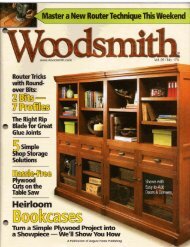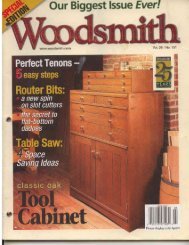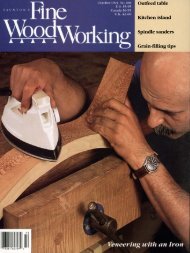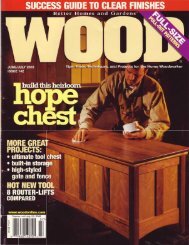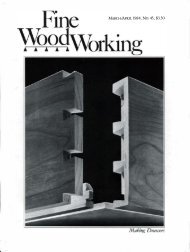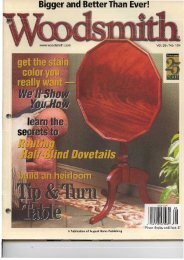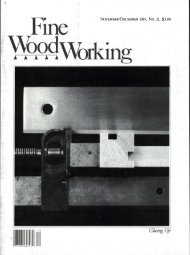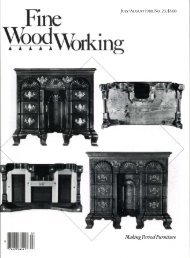take out the middle drawer, turn it over, remove the scr w holdingthe bottom, slide out the bottom and look. The drawer backwas partially hollow. With a horizontal mortiser, I had made twoV4x6xl1/2-in. slots in the bottom edge of the drawer back, oneon each side of the screw hole. The coins could then be wrappedin felt or tissue to keep them from rattling. With the bottom replaced,there is no reason to suspect the hiding place (see method5 at the bottom of the previous page).Desks -In addition to the drawer methods, desks lend themselvesto a host of different hidden compartments. I've always suspectedthat pigeonholes in roll-top and slant-top desks were originallyconceived by cabinetmakers to allow themselves room to play withthese ideas. Everyone has seen a slant-top desk with two flutedhalf-columns that pull out and are actually narrow drawers. Theseare practically institutions, and not secret by any means (at leastnot now). Another common metho I often found in the pigeonholesof slant-top desks is a thin drawer behind the molding or scallopedfacia above the pigeonholes. These parts either pull out likedrawers or hang on hooks, clips or magnets. Roll-top desks sometimeshave small corner brackets in the pigeonholes that pull outto reveal a tray just big enough to hide two, always eluSive, pencils.Pigeonholes, letter slots or compartments with doors are alsoideal locations for false backs. A compartment behind a false backis not readily apparent if it is not too deep, especially if the surroundingareas are filled with books or papers. The created spacecan be reached either from the front, by reaching in and removinga part of the back panel, or through a removable panel near theback of one of the vertical dividers, as shown in figure 2A below.Either way, the access panel should be as unobtrusive as possible.I've used several methods with either hinged doors or loose panels.One of my favorite devices is the magnetic-touch latch, a boonfor makers of secret compartments: Just push on the panel, and itpops right out. For a hinged door, one latch will suffice; for aloose panel, two, with doorstops, should be used. Panels anddoors should fit as tightly as possible without binding.An alternative to the touch latch is illustrated in figure 2B below.In this method, dle panel is made as wide as dle opening, but in.taller, widl a discreet fingernail catch incised with a gouge on thefront of the panel. The panel is lifted into the 'l'16-in.-deep uppergroove, pushed into place and dropped into the Ys-in.-deep bottomgroove. Because of thestill held in place above.hallow bottom groove, dle panel isWhenever possible, access to the hidden area on desks or otherlarge pieces should be from the front, sides or interior of thepiece. Only once have I run across a compartment reached through ahinged door in the back. Thi entails moving the piece away fromthe wall to gain access, which is not only difficult, but in the caseof a full bookcase or large wardrobe, almost impossible.Hollow posts -Anodler traditional hiding place, somewhat reminiscentof Bat Masterson'S cane, is the hollowed-out post. The hollowsusually consist of drilled-out holes, which limit the amountand type of storage space available. On dle odler hand, you wouldbe surprised at how many $20 bills can be rolled up and slid into alY2-in.-dia. hole. If coins are to be hidden, it's best to tailor the holeto accept a plastic vial, which is easier to remove than loose coins.Turned posts are generally much easier to work with thansquare ones, because the cap for the compartment can join dlepost in an inconspicuous place. The underside of a ball or ring, ora scribe line is perfect for dlis. The bedpost in figure 3 belowshows how convenient a finial is for capping a hollowed-out post.To make this sort of secret compartment, I turn the post as I normallywould, but I allow 1'2 in. to 1 in. of extra lengdl for thetenon, which I turn directly below the portion of the post that willbecome dle removable cap. This tenon's diameter must match oneof your drill bits so the cap will fit snugly into the hollowed-outcomparunent you will drill in the post. When I've turned the tenonFig. 2: Removable panels (behind pigeonholes)Fig. 3: Hollow postB: Double grooves behind pigeonholesHole.1'12 in. dia.44 Fine Woodworking
-----.JFig. 4: Hanging tray below tabletopShim, 'Is in.Sliding bolt screwed to underside of tabletop.\TablerailNotch divider toallow clearance forsliding bolt.DrawerLedgerstrip ___-----Hanging tray drops Idown and out when bolt is unlocked.IRemove drawer toreach sliding bolt.to the proper diameter, I remove the post from the lathe and sawthis top portion off just below the tenon. Using the bit that coin·cides with the tenon's diameter, I drill a hole in the sawed-off endof the post. The depth of this hole minus the tenon determines thesize of the hollow storage area. The cap can also be drilled out fo radditional space.Figure 3 also shows the small wooden "key" on the tenon,which not only aligns the grain, but keeps the finial from turningshould some unsuspecting soul inadvertently place their hand on it.To locate d1is key, I place a dun wire in d1e hole, align the grain to itsoriginal position and force the tenon into the hole. The wire compressesthe wood and thereby marks the location fo r a Ys-in.-deepby Y4-in.-wide groove that I carve into each piece. The xl/4 xl/2-in.key is then glued into the groove on the tenon. The drilled-outpost can now be rechucked in the lathe and turned to suit, usingeither a wooden plug or a bullnose dead center to mount d1edrilled end.into dadoes in the fa lse top and the first shelf. I couldn't bear toseal such a marvelous space without getting some use out of it. So,I made a trapdoor in the false top that I could push up from insidethe cabinet to get at this space (see figure 5 below).To build the trapdoor, I marked the locations of the two dadoesto be cut (front to back) in the false top, then ripped the top(side to side) into three sections, about one-fourth of the wayfrom the front and one-fourth of the way from the back. I thencrosscut the center section of the wide middle piece along thedado lines. The fa lse top was now in five pieces. Next, I regluedthe two long pieces and the two outside pieces of the centersection together, creating a rectangular opening in the centerwhere the remaining piece would fit snugly. I took one pass offthe edge of this piece with a block plane, then screwed on tworibs perpendicular to the grain, extending Y2 in. on each side.After sanding, the top was dadoed and installed, and the dividersTables -There is a vast amount of space behind the rails or apronunderneath the top of a table. Except for children parking theirgum (or maybe because of d1is), very few people actually fondlethe underside of a table, so this otherwise wasted space is ideal forconcealing hanging trays. A hanging tray can be u ed even onsmall coffee or end tables and below the seats of chairs that haveside rails. It can be hinged on one end or merely rest on a ledgerstrip, with tl1e other end resting on a removable strip held in placewid1 dowels or pins. In figure 4, above, I've shown an example of atable with a center drawer that has a hidden tray resting on a ledgerstrip on d1e left and held up with a sliding bolt on the right.With the drawer removed, and with one hand supporting d1ehanging tray, you reach in and unlock tl1e sliding bolt. This unlockedend of the tray can now be lowered until it comes off theledger strip on the other end.If the table has a drawer, so much the better. Because mostdrawers don't extend the fu ll widtl1 of the tabletop, you can placetwo drawers on the same track, one behind the other.Tops and bottoms of cabinets -Other areas often overlookedand generally underutilized are the spaces between tops and thespaces inside boxed-in bases of cabinets. On many highboys, fo rexample, d1e bonnet top is hollow, usually with no access. I recentlybuilt an armoire with a 3-in. molding around the top. Inaddition to d1e cabinet top, there is a false top Y2 in. below themolding that acts as a doorstop. Two dividers were to be insertedFig. 5: False top in cabinetTo conceal paneledges, locate themabove dadoesfor dividers.False topTrap door liftsup and slides over.Rip, cut outsection for trapdoor; reglue.January/February 1989 45
- Page 3 and 4: FineW> rktng'_' ______ ___ January/
- Page 6 and 7: Letters (contillued)never hurt hims
- Page 8 and 9: MetiJods of Wo rkedited and drawn b
- Page 10 and 11: Methods of Wo rk (contillued)exampl
- Page 12 and 13: Making a door sandwichI intend to m
- Page 14 and 15: Q & A (colltillued)of a bad situati
- Page 16 and 17: Pollou'-upby Dick BurrowsMore on to
- Page 18 and 19: Easy toStep by Step DrawingsBuildOn
- Page 20 and 21: (25 years)P-SOO20" PlANERSEATTLE:1
- Page 22 and 23: There areover 4,000money-savingreas
- Page 24 and 25: READY TO ASSEMBLE-SOLID-CHERRYWALNU
- Page 26 and 27: THE BARTLEYBUNDLES!AlJ.500 ·24"Ban
- Page 28 and 29: A GREAT DEA.L IMORE (f)5 HP, 3 Ph3
- Page 30 and 31: --ANTIQUE & USED TOOLSQuality, olde
- Page 32 and 33: PhoneStater--- - -[][]Ur:iTheWoodwo
- Page 34 and 35: """""',' Universal Precision Measu
- Page 36 and 37: FineWorking January/February 1989M
- Page 38 and 39: Once the backrest plaques are joine
- Page 41 and 42: Fig. 4:.1:iim.lf1lmllli.iiiiie?tII
- Page 43: Secret compartments were so common
- Page 47 and 48: Tbree examples of the author's slid
- Page 49 and 50: worked but will maintain a crisp, s
- Page 53 and 54: SCROLL-SA W TESTCompany and model L
- Page 55 and 56: An ordinary woodturning lathe can b
- Page 57 and 58: use a dust collector, and if possib
- Page 59 and 60: I've never been especially fond of
- Page 61 and 62: and it shields your fingers from ex
- Page 63 and 64: The cabinet scraper used by the aut
- Page 65 and 66: Fig. 2: Post:Modern Table Top, 52 i
- Page 67 and 68: Fig. 3: LFI TableNut is fastened to
- Page 69 and 70: Fig. 3: Curved miterPattern doesn't
- Page 71 and 72: Selections from the author's sketch
- Page 73 and 74: thor anticipate problems and make f
- Page 75 and 76: Fig. 2: Air flowMoist air exits thr
- Page 77 and 78: lating fan. The idea here is to ins
- Page 79 and 80: Long prized by woodworkers for its
- Page 81 and 82: A Chinese woodworker assembles an e
- Page 83 and 84: Chinese shaping toolsThroughout Chi
- Page 85 and 86: Using a Holtzapffel ornamental lath
- Page 87 and 88: NOW! BUY BRIDGEWOOD IN CANADA . ..
- Page 89: QiUl j!! IIIc:Ul.=:c ...!!
- Page 92 and 93: 111,"11SIOPm'EI.I,lu it ....IS •
- Page 94 and 95:
CARBIDE TIPPED ROUTER BITSPRCAL PRO
- Page 96:
FS Tool CorporationP.o. Box 510, 21
- Page 99 and 100:
... !Ij*;::""' eMore NTS 14-5614" H
- Page 101 and 102:
FI:\ISHI:\G SLPPLIESIf you have bee
- Page 103 and 104:
T\UNTONPUBliCATIONS... by fellow en
- Page 105 and 106:
PmeWqqQWorkingIndex to issues 66 th
- Page 107 and 108:
FowlerFowler, Brian, chair by, 67,1
- Page 109 and 110:
ScrewsZimmerScrews:brace driving of
- Page 111 and 112:
34-76 1 10' Uni s-l-l/2 hp ........
- Page 113 and 114:
MOISTURE METERFAMOUS "MINI-LiGNO"MA
- Page 115 and 116:
Dependable extra hands for all type
- Page 117 and 118:
MIRRORA· THE HAND MIRRORCOMPLEMENT
- Page 119 and 120:
£'Delrl.lnc'e To Manufacture Quali



